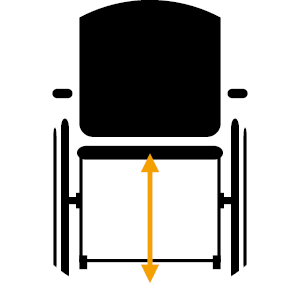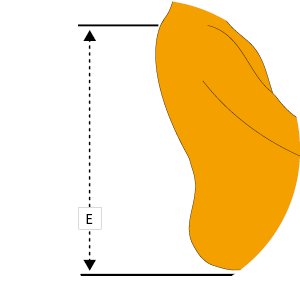How to take measurement for your wheelchair
A correct sized and correctly fitted wheelchair is important to enable the user to maintain participation in the activities of everyday life as much as possible. A wheelchair is a means of transport, primarily intended to compensate for the loss of the walking function. The user of a comfort wheelchair sits daily in average 8-10 hours in a wheelchair. For this reason, it is important that the wheelchair offers good driving characteristics and maximum sitting comfort as well as the possibility to switch between activity and rest. The following section explains how to measure to find the right size for a wheelchair.
Hip width / seat width
A: Taking the right measurements is important to ensure stability of the pelvis and hips. The wheelchair must be as narrow as possible to ensure a good sitting and driving position. The seat width A is measured in a straight line across the widest part of the hips in a seated position. Important: when you order chair from the Netti II or III Family, please note that there is a little more than 10 mm between the seat cushion and the armrest on each side. So, for a perfect fit you should consider ordering 20-25 mm less in width. Please also consider that if the wheelchair is to be used indoor as well as outdoor with winter clothes, the extra space may be needed.
THIGH LENGTH / SEAT DEPTH
B: When correctly measured, optimum seatcontact area is achieved and at the same time it prevents the user from sliding out of the chair. The thigh length is measured from the rearmost point of the buttocks to the hollow of the knee. Then about 30 mm or 2 finger widths are subtracted so that the calf is not in contact with the seat cushion in front. If the chair is to be foot-propelled, a few more centimetres are subtracted. For different leg lengths the measurements are taken on the shorter leg. If the user suffers from a contracted knee joint, it must be ensured that the calf does not touch the seat cushion or the underlying frame structure.
Seat depth measurement for bariatric users
X: When dimensioning the seat depth for a person with a heavy weight, it must be noted, that the buttock area usually protrudes lightly toward the back over the vertical line from the shoulder-blades (see the area x). To provide the user of the wheelchair with a back support which is appropriate to his/her body shape, the wheelchair back needs to be positioned in front of area X. To provide sufficient seat depth and to give postural support, the back support of the wheelchair must be able to give space for area X. Adjustable straps are therefore recommended.
B: Measure the seat depth range B. This is the seat depth you need for the wheelchair.
ARM SUPPORT HEIGHT
C: When sitting for long periods, strain is put on the back muscles and one feels the need for relief. The correct height of the arm support provides a good sitting position and allows for some change in the sitting position. The height is measured from the bottom of the elbow to the top of the seat cushion. Make sure the shoulders are relaxed and let the arm hang straight down. To create a good arm support you should add 50 mm to this measurement due to the fact that the arms normally are placed slightly forward, (see picture) and we need relaxation in the shoulders.
LEG LENGTH
D: When correctly adjusted seat height, the pelvis is stabilized and the pressure between tights and seat cushion is evenly distributed. This is achieved by adjusting the distance between the leg support foot plates and seat cushion to the user’s leg length. The leg length is measured vertically from the hollow of the knee down to below the heel while the knee is in a preferable 90-degree angle. Important: The shoes worn by the user every day must be included in the measurement.
SEAT HEIGHT CONSIDERATIONS
The seat height will depend on whether the user can move the chair with their legs or use the leg supports. If the user intends to propel the chair with their feet, the height of the wheelchair seat should be 20-30 mm lower than the measured leg length. If the user intends to use the leg supports, the seat height of the wheelchair should be higher. The free space under the foot plates must be 20-30 mm when driving indoor and 40-50 mm when driving outdoor.
BACKREST HEIGHT
E: The backrest height is measured from the seat to the highest part of the shoulder-blade in the seated position. All Netti wheelchairs can be supplied with several types of back cushions in different backrest heights of 400-600 mm. All Netti wheelchairs have a Velcro backrest allowing for individual height adjustment of the back cushion. If the user manoeuvres the wheelchair with the arms, the back cushion must not impede the movement of the arms and shoulders. The correct backrest height also provides for greater comfort and supports the back. The Netti back cushions allow enough space for arm movements.
TRUNK WIDTH
F: The trunk width is measured horizontally at the level of the lower tip of the shoulder-blade. This measure is to evaluate the required distances between the integrated side supports of the back cushion. The goal is an optimal trunk support.
Please do not create a trunk-width which is too narrow as this can cause pressure ulcers. If the distance between the trunk and the side support is more than 30 mm per side, you can use a spinal wedge to secure the stability.








